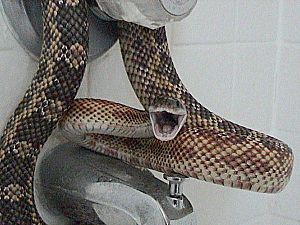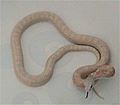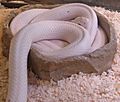Texas rat snake facts for kids
Quick facts for kids Texas rat snake |
|
|---|---|
 |
|
| Scientific classification |
|
| Kingdom: | Animalia |
| Phylum: | Chordata |
| Class: | Reptilia |
| Order: | Squamata |
| Suborder: | Serpentes |
| Family: | Colubridae |
| Genus: | Elaphe |
| Species: |
E. obsoleta
|
| Subspecies: |
E. o. lindheimeri
|
| Trinomial name | |
| Elaphe obsoleta lindheimeri (Baird & Girard, 1853)
|
|
| Synonyms | |
|
|
The Texas rat snake (Elaphe obsoleta lindheimeri) is a type of rat snake. It's a non-poisonous snake found mostly in Texas, but also in Louisiana, Arkansas, and Oklahoma. This snake mixes with other kinds of rat snakes, so it's hard to draw exact borders for where they live. The name lindheimeri honors Ferdinand Jacob Lindheimer. He was a German-American naturalist who found the first snake of this kind in New Braunfels, Texas.
Contents
About the Texas Rat Snake
The Texas rat snake is a medium to large snake. It can grow to be about 4 to 5 feet long. Their colors and patterns change a lot depending on where they live. Usually, they are yellow or tan. They have brown to olive-green blotches, which are like irregular spots, from their head to their tail.
Color and Markings
Snakes from the southern parts of Texas are often more yellow. Those from the northern areas tend to be darker. One special way to tell them apart is their solid gray head. No other rat snake has this feature. Some snakes also have red or orange speckles. Their belly is usually a solid gray or white color.
Special Color Types
There are a few natural color changes that happen in these snakes. Some are albino, meaning they are white with red eyes. Others are "high orange" or "hypomelanistic," which means they have less dark pigment. Some even show leucism, making them mostly white with blue eyes. These special color types are often bred by people and are popular as pets. In some parts of Texas, like Sabine County, these snakes can be very black with white spots. This shows they are mixing with the black rat snake.
How Texas Rat Snakes Behave
Texas rat snakes are usually shy for such a large snake. However, their behavior can be very different from one snake to another. Adult snakes might be calm, but they can open their mouths wide or bite if someone gets too close. Young snakes, less than a year old, can be either very gentle or bite when bothered.
Defensive Moves
When they feel threatened, these snakes have a few ways to protect themselves. One way is by "rattling" their tail. They quickly whip the end of their tail back and forth against anything nearby. This makes a sound like a rattle. They also release a bad-smelling musk. This smell is much worse than what other snakes produce. In captivity, they eat easily. They will eat frozen mice and rats that have been thawed. Snakes caught in the wild usually become calm over time when kept as pets.
What Texas Rat Snakes Eat
The Texas rat snake loves to eat. They eat many rodents and birds. Sometimes, they also eat lizards, soft-bodied insects, and frogs. They catch their food by constriction, which means they squeeze their prey until it can't breathe.
Where They Live and Hunt
These snakes are not picky about where they live. You can find them in many different habitats. This includes swamps, forests, and grasslands. They even live in cities. They are very good at climbing. They can easily reach bird nests high up in trees. People often find them near farms. Sometimes, they eat young chickens and eggs. Because of this, they are sometimes wrongly called "chicken snakes."
Taxonomy: Naming the Snake
Scientists have suggested that all North American rat snake species should be put into a new group called Pantherophis. Some even think that the different types of Pantherophis obsoletus are just local versions and not separate subspecies. However, the ICZN, which is the group that names animals, has decided to keep the name Elaphe. So, Elaphe is still the accepted name for these snakes.
Gallery




